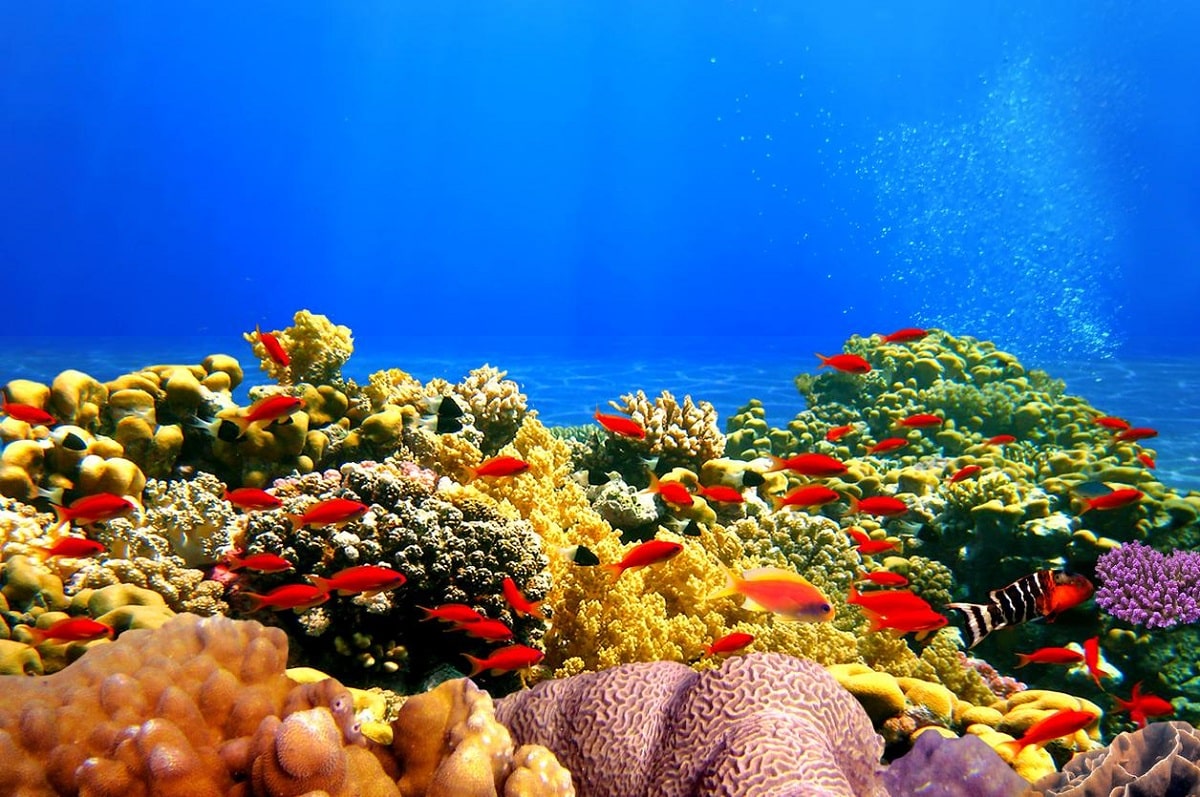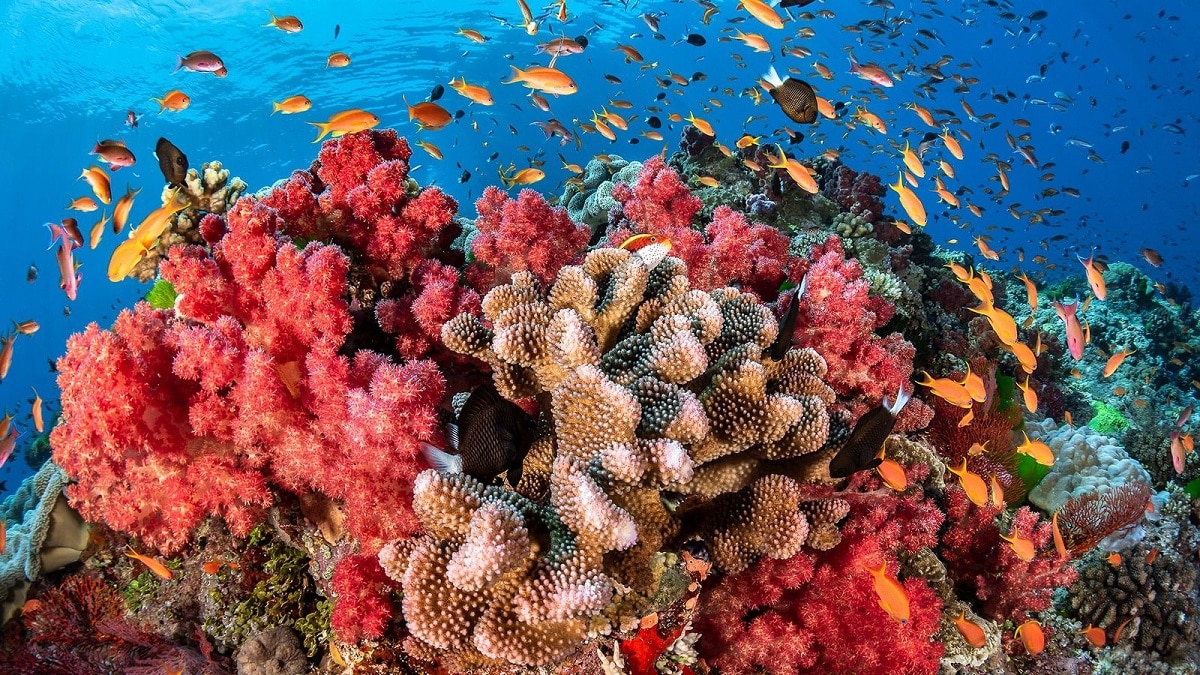
The reefs Corals are elevations formed at the bottom of the sea by the biological action of organisms called polyps. These biological structures are found in shallow waters of tropical seas where the temperature ranges between 20 and 30ºC. They are of great importance for the environment and the regulation of the oceans and biodiversity.
Therefore, we are going to dedicate this article to tell you all the characteristics, origin and importance of coral reefs.
What are coral reefs

Coral polyps belong to the class Anthozoa (phylum Cnidaria), and their anatomical structure is simple. They have radial symmetry and a cavity formed by two layers of tissue, separated by a septum.
The body of the coral has an opening, or mouth, for both feeding and excretion. They have a series of barbed tentacles around their mouths, which they use to catch their prey.
There are soft corals and hard corals, the latter being the reef-building corals. The hardness is given because they form a layer of calcite (crystalline calcium carbonate) on the body.
These polyps form extensive colonies with a combination of sexual and asexual reproduction, and their development requires brackish, warm, clear and agitated waters. The development of these colonies created a structure that was built as a refuge against currents and as an attractor of life and food.
According to the geological conditions and the ecological dynamics of the area, three basic types of coral reefs have been formed. One is the littoral coral reefs that form along the coast. Other types are barrier reefs and atolls (islands formed by a ring of coral reefs and a central lagoon) far from the coast.
Coral reefs are inhabited by a variety of chlorophyll, macroalgae (brown, red, and green), and coralline algae. The fauna has many species of corals, fish, invertebrates, reptiles (marine turtles) and even aquatic mammals such as manatees.
Invertebrates include snails, octopus, squid, shrimp, starfish, sea urchins and sponges. The largest coral reefs in the world are the Coral Triangle in Southeast Asia and the Great Barrier Reef in Australia. Likewise, the Mesoamerican-Caribbean reefs and the Red Sea reefs.
Despite their importance to marine ecology and global biodiversity, coral reefs are under threat. Threats to these ecosystems include global warming, ocean pollution, and coral mining.
There are also biological threats, such as the overpopulation of coral-eating species such as the crown-of-thorns starfish.
General characteristics

a coral reef is any height on the seabed at a depth of 11 meters or less. It can be a sandbank or rock, or even an artificial reef created by a shipwreck. In the case of coral reefs, it is the uplift caused by biomes that produces calcareous exoskeletons.
Coral reefs thrive in tropical seas around the world, in the Americas with the Gulf of Mexico, Florida, and the Pacific coast from California to Colombia. They are also found along the Atlantic coast of Brazil and in the Caribbean, including the continental and island coasts.
In Africa they run along the tropical Atlantic coast, while in Asia they are found in the Red Sea, Indo-Malay Islands, Australia, New Guinea, Micronesia, Fiji, and Tonga. Coral reefs are estimated to cover 284 to 300 square kilometers, 920 percent of which is in the Indo-Pacific region. 000% of the world's coral reefs are distributed between Indonesia, Australia and the Philippines.
Morphology
Polyps are radially symmetrical, and the body cavity is divided into compartments by radial partitions, that is, they resemble a sac (coelenterate). This sac, called the lumen or intestine, includes an opening to the outside (mouth).
The mouth is used for both the entry of food and the expulsion of waste. Digestion occurs in the lumen, or lumen, of the gastric vessels. The mouth is surrounded by a ring of tentacles., which they use to catch their prey and bring it to their mouths. These tentacles possess stinging cells called nematoblasts or cnidocytes.
Cnidoblasts consist of a cavity filled with a stinging substance and coiled filaments. At its end is a sensitive extension that, when aroused by touch, shoots out tangled filaments.
The filaments are submerged in a stinging liquid and penetrate the tissue of the prey or attacker. The body of these animals consists of two layers of cells, The outer one is called the ectoderm and the inner one is called the endoderm.. Between the two layers is a gelatinous substance called a mesoplasty. Coral polyps do not have specific respiratory organs, and their cells absorb oxygen directly from the water.
Dinoflagellates (microscopic algae) live in the delicate translucent tissue of coral polyps. These algae, known as zooxanthellae, maintain a symbiotic relationship with polyps.
This symbiosis is mutualism (both organisms in the relationship benefit). Zooxanthellae provide carbon and nitrogen compounds to polyps, and polyps provide them with ammonia (nitrogen). Although some coral colonies were free of zooxanthellae, only those coral colonies that exhibited this association formed reefs.
Coral Reef Nutrition

In addition to obtaining the nutrients provided by zooxanthellae, coral polyps also hunt at night. To do this, they extend their tiny spiny tentacles to catch small marine animals. These tiny animals are part of the zooplankton carried by ocean currents.
Environmental conditions
Coral reefs require shallow, warm and choppy water conditions. They will not develop in waters where the temperature is below 20 ºC, but very high temperatures will affect them negatively, their ideal temperature range is 20-30 ºC.
Some species can develop in cold waters between 1 and 2.000 meters deep. For example, we have Madrepora oculata and Lophelia pertusa, which are not related to zooxanthellae and are white corals.
Corals cannot develop in deep ocean areas because zooxanthellae need sunlight for photosynthesis.
I hope that with this information you can learn more about coral reefs and their characteristics.